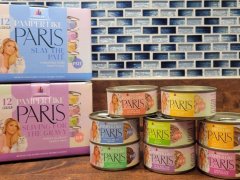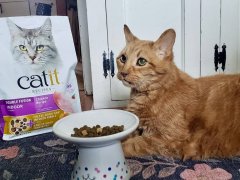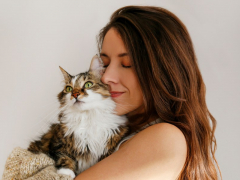
Kirsten McCarthy / Cats.com
Most veterinary nutritionists agree that wet cat foods are better for a cat’s health than dry cat foods. But does this mean that dry food is bad for cats?
No. Because all cats are individuals with individual needs and preferences, and no two diets are the same. In fact, there are some scenarios where dry food might be the best choice for your cat.
Dry cat food typically contains more carbohydrates than wet food, which can lead to concerns about obesity, diabetes and other health related issues in cats Higher moisture content in wet food helps maintain a cat's hydration and can be beneficial for cats that don't drink enough water on their own. Dry cat food is often a budget-friendly option, making it suitable for those on a strict budget or individuals feeding community cats. It tends to be less expensive than canned foodKey Takeaways
There really is no one-size-fits-all when it comes to nutrition. The good news is that most complete, commercially available diets will provide your cat with everything they need, whether they are wet or dry.
This article will help you understand the differences between wet and dry cat food and why dry food might not be as optimal for your cat’s health as wet. It will also explain when dry food might be the best option, and what to look for if you want to choose a dry food for your cat.
Dry vs. Wet Cat Food
Whilst a complete, balanced dry diet (kibble) is certainly not bad for cats, wet food is usually considered to be a better choice. So, what exactly is the difference between wet and dry cat foods?
Moisture Content
One of the main differences between wet and dry cat foods is their moisture content. Whereas wet cat foods tend to contain 60-80% water, most dry diets contain only around 10% water. Although cats fed dry food usually drink more to compensate for this, research has shown that cats fed only dry food have a lower overall water intake.
Encouraging water intake is important for all cats to prevent dehydration. It is especially important for those with kidney disease or lower urinary tract diseases, such as cystitis. So, if your cat is not a big drinker, or suffers from urinary tract disease, wet food could be the better option. If wet food isn’t an option, simply adding water to your cat’s dry food can provide some of the benefits of wet food.
Calorie Content
As well as being beneficial for urinary health, the higher water content in wet food means it is much lower in calories per gram than dry food. This means cats can eat more– and therefore feel fuller – without gaining weight. Wet food also tends to contain less carbohydrates and more protein, which helps to promote weight loss. Therefore wet food is a good choice for cats struggling with obesity.
Palatability
As we know, cats are individuals, with individual likes and dislikes! But in general, the higher protein and fat levels in wet cat foods make them more palatable than dry. But it isn’t all about taste: cats have very few taste-buds compared to humans, so the texture and smell of their food are more important than the flavor. Wet food is stronger smelling and comes in more varied and exciting textures than dry food.
The extra tastiness, smell, and texture of wet food make it a good choice for fussy eaters, or those suffering from illness. It is also easier to chew for cats with dental disease, or recovering from dental treatment.
When To Buy Dry Cat Food

Kirsten McCarthy / Cats.com
With its higher moisture content, lower calorie density, and increased palatability, wet food is the optimal choice for most cats. But there are some situations where dry cat food might be more appropriate.
Gaining Healthy Weight
Whilst the lower calorie content of wet food is great for cats who are on the chunkier side, it is often not the best option for cats who are underweight.
Due to its density, dry food provides higher levels of energy and nutrients packed into a smaller volume. This means that dry food can be the best option for cats struggling to maintain or gain weight.
Oral Health
If you want to look after your cat’s teeth, there is no substitute for tooth brushing. But not all cats are keen on having their teeth brushed! So, does the type of food make a difference?
Research shows that cats fed wet only diets tend to get more plaque on their teeth than cats fed only dry food. We used to think this was because dry food scraped the surface of the teeth when cats chewed it. However, some studies suggest it might be because dry food increases saliva production, and it is the extra saliva that is protecting against the formation of plaque.
Either way, the jury is still out on exactly what the benefits of dry food are for oral health in cats. Importantly, if you are looking to choose a dry diet because of the benefits for your cat’s teeth, make sure it is one that is assessed as effective by the Veterinary Oral Health Council (VOHC).
Prescription Diets
There are many diets available nowadays that are specifically formulated to help treat certain diseases, such as diabetes and heart disease. These prescription diets are only available from your veterinarian and must be used under their supervision. This is because these diets contain nutrients in a different ratio to normal cat food. They are carefully formulated to treat a certain disease and are not suitable for cats without that condition.
Many veterinary-prescribed diets are available in both wet and dry options, meaning the choice is yours. But if your veterinarian has prescribed a therapeutic diet that is only available in a dry formulation, it is almost certain that the benefits of this diet outweigh the disadvantages of it being a dry food. Be sure to discuss any concerns about feeding a cat with a health condition with your veterinarian.
Lifestyle Stage
Certain lifestyle stages, such as pregnancy and lactation, require diets high in carbohydrates and calories to keep up with the extra demands on the body. Dry diets are usually the best choice as they are much more energy and nutrient-dense (due to their low water content) and higher in carbohydrates – the preferred energy source for pregnant or lactating cats.
Grazers
Most wet cat foods rapidly dry out and spoil when left down for more than about an hour. This means that wet food is not be a good choice for cats who prefer to graze on their food throughout the day.
If your cat is a grazer – or you are out of the house for a long time – dry food is a more convenient and hygienic choice. It stays fresher for longer and won’t spoil if your cat likes to pick on it throughout the day.
Cost
Of course, cost is a significant factor when choosing the best diet you can for your cat. As dry food is more energy-dense (meaning you don’t have to feed as much) and lasts longer, it is significantly cheaper to feed than wet food.
A premium dry food may offer your cat better nutrition than a budget wet food. In this next section, we will help you know what to look for in choosing a great dry food for your cat.
What To Look For in a Dry Cat Food

Kirsten McCarthy / Cats.com
Whilst wet food has many advantages over dry food, dry food is still a good option for many cats. It is energy and nutrient-dense, economical, and easier to store and feed – particularly for grazers.
But with so many options on the market – and a lot of clever marketing tools at play from pet food manufacturers – it can be hard to know where to start. So, what should you look for when you are choosing a dry cat food for your cat?
Check for a Nutritional Adequacy Statement
The most important thing to check when choosing a diet for your cat is that it is nutritionally complete and balanced for their life stage. Whilst there can be an overwhelming amount of information on pet food labels (and often a lot of ambitious claims!) the Nutritional Adequacy Statement is the one thing you definitely need to check for.
This statement tells you that the food is complete and balanced for the intended life stage. It will read something like ”…formulated to meet the nutritional levels established by the AAFC cat food nutrient profiles for all life stages”.
Food that is not nutritionally complete and balanced may be labelled as “complementary” or “for supplemental or intermittent feeding only”. This means they should only be fed as a small portion (less than 10%) of your cat’s diet.
Lifestyle Stage
Your cats’ nutritional needs will vary a lot throughout their life. Whilst there are some diets that are “all life stage diets”, these only need to meet the minimum requirements for nutrition at each stage. If possible, choose a food that is formulated specifically for your cat’s lifestyle stage, for instance, kitten, adult, or senior. This means you know they are getting the optimal nutrition at every stage.
For example, senior cat foods have increased levels of digestible protein to help older cats maintain their muscle mass. They also often have added essential fatty acids for joint health. Kitten foods are high in fats and protein, ideal for growth.
High Protein, Low Carbohydrate
As hunters, cats have evolved to thrive on a diet that is high in protein (approximately 50% of their calories), low in carbohydrates (5-15% of their calories), and moderate in fat (approximately 45% of their calories).
To make life tricky, dry cat food diets tend to be lower in protein and higher in carbohydrates than wet cat foods. Therefore, it is important to choose a dry food that meets their needs as closely as possible.
Unfortunately, cat food labels do not need to list carbohydrate content. But you can use this online calculator to work out the carbohydrate content from the other nutrient values listed.
Animal Protein Sources

Kirsten McCarthy / Cats.com
It isn’t only the amount of protein that matters, but where it comes from. Cats are obligate carnivores. So, whilst cats can digest both plant and animal-based proteins, only animal proteins provide them with all of the essential amino acids they need – particularly taurine. Make sure you look for a whole meat listed as the top ingredient, and ideally the top three.
It is possible to feed a nutritionally balanced vegetarian diet. But these are usually only appropriate for cats with severe allergies who need a diet that does not contain animal proteins. These diets are formulated by specialist nutritionists and must be prescribed by a veterinarian.
If you wish to feed your cat a vegetarian diet, you should only do so under the guidance of your veterinarian. It is not possible to safely feed a cat a vegan diet.
Go Natural
Cat foods labeled as “natural” contain 95% natural ingredients and have only been subjected to basic processing such as freezing or drying). This means you know there are no artificial flavorings, colors, or preservatives that could affect your cat’s health.
Cost
In general, the more expensive a cat food is, the higher the quality of the ingredients. You should aim to feed your cat the highest quality food you can within your budget. Given how much cheaper dry food is to feed compared to wet food, you may be able to afford a more premium range of dry food compared to a budget wet food.
Budget range cat foods often contain a “variable” recipe. This means they can change the ingredients without informing you or doing a new feeding trial. This variability can lead to tummy upsets or cat’s suddenly going off their food.
More expensive foods such as premium and prescription diets usually have a “fixed” formula, meaning the formulation can not be altered without informing you and undertaking new feeding trials.
However, the cost of food does not always reflect the quality. Sometimes, pet food is expensive because they have invested in clever marketing tools. So you need to look for a pet food brand you can trust.
Choosing a Trusted Brand
When looking for a cat food brand you can trust, the first thing you need to look for is transparency. Are their company contact details easy to find? Who is formulating their diets and what are their qualifications? Do they meet Association of American Feed Control Officials (AAFCO) standards? Are their claims backed by scientific evidence?
All this information should be readily available on the company website or provided if asked. Your cat food company should be able to provide you with the amount of any nutrient in their food, not just what is listed on the label (which are often only minimum and maximum values). Failing to provide this information is a real red flag.
This guide by the WSAVA Global Nutrition Committee is a great starting point for choosing a pet food brand you can trust.
Conclusion
Overall, wet food is the optimal choice for most cats. But for the right cat, dry food can still be a good option. Dry food is cheaper and easier to feed than wet food, and as long as it is complete and balanced, it will offer your cat everything they need.
However, remember you don’t have to choose one or the other! Using a combination of wet and dry food can also give many of the benefits of a wet food diet, whilst reducing the overall cost. This also allows for “free-range feeding” of dry food for cats who like to graze, whilst including wet food in their main meals.
As we know, all cats are individuals! You’ll need to consider your cat’s health, preferences, and lifestyle when it comes to choosing the best food for them.
Frequently Asked Questions
Is it better to feed cats wet or dry food?
Most experts agree that wet cat food is more optimal for cat's health than dry food. This is because it has a higher moisture content, is lower in carbohydrates and higher in protein, is lower calorie and more palatable than dry food. However, a complete and balanced dry cat food will still give your cat everything they need, whilst being cheaper and more convenient to feed.
Does dry food hurt cat's kidneys?
Research shows that the overall water intake of cats fed wet food only is higher than cats fed dry food only. A low water intake has been linked to a number of diseases, particularly kidney and lower urinary tract disease such as cystitis. But there is currently no clear evidence that dry food can cause kidney disease in cats.
Is it OK to mix wet and dry cat food?
Yes! Mixing wet and dry food can give the benefits of wet food (increased water content, lower calorie, lower carbohydrate and higher palatability) whilst being cheaper to feed than a pure wet food only diet. It can also allow for 'free-range feeding', meaning dry food can be left down to graze on, and wet food fed with meals.
-
Seefeldt SL, Chapman TE. Body water content and turnover in cats fed dry and canned rations. Am J Vet Res; 1979 40:183-185. (lower water intake when fed dry food). Retrieved June 22 2023.
-
Mata F. The Choice of Diet Affects the Oral Health of the Domestic Cat. Animals (Basel). 2015 Feb 16;5(1):101-9. doi: 10.3390/ani5010101. PMID: 26479140; PMCID: PMC4494333. Retrieved June 22 2023.








I’m a two cat family – unfortunately, one is a grazer and the other a “eat whatever is available”. How do I handle this so that each get what they need – not necessarily what they WANT. Thanks
I have 3 indoor cats, seniors, and feed 6 strays that stay in the yard. I’ve managed to get them all spayed/neutered but I’m in the middle of changing my indoors cats diets since one was diagnosed as diabetic due to steroid use. I’ve been pricing out their new food and it will be impossible for me to feed all of them.
I’ve been searching for a list of the best least expensive dry food that will be kind to my budget, would there be such a list here? I am trying to find one type of dry food that can be fed to all, if possible, even if excluding the diabetic cat. Preferably available through Chewy.
Hello there Rita! Thanks for your interest. We have a list of the best budget-friendly cat food here.